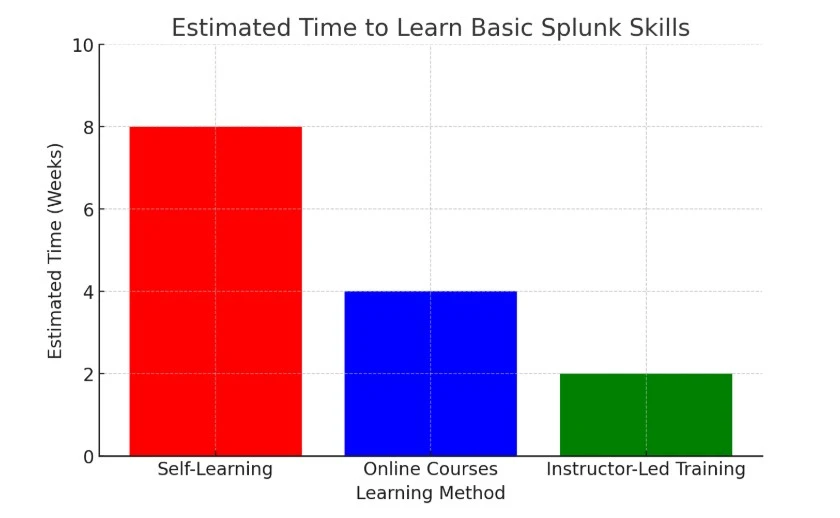Picture this: your company data is a tangled mess, like a plate of spaghetti after a wild party. You're eyeballs deep in logs, security threats are popping up faster than roos at dusk, and your IT team's running around like headless chooks. You've been told that Splunk might be the answer, but the million-dollar question is: "Is this thing learnable, or am I going to add another complication to my already full plate?"
You need to get Splunk learning certification fast to cut through the digital static, gain hands-on expertise, and start making sense of your data. And you're not alone. Many companies across Australia and New Zealand are suffering the same data deluge. So, let's break it down and see if Splunk is a friend or foe to the newbie.
What are Splunk learning paths for beginners?
Okay, so you're ready to dive into Splunk. Where do you start? It's like learning to surf; you don't immediately go out to the giant wave. You start in the little waves.
- Splunk Fundamentals 1: This is your initial "learn to paddle" class. It makes you familiar with the Splunk interface, how to navigate it, and how to search your data. You'll be looking at dashboards and basic queries.
- Data ingestion: First, you must determine how to get all that data into Splunk. It's akin to reading the waves; you need to know where the data originates and how to get it in without crashing. If you're working in software development, this is especially useful for monitoring logs, debugging applications, and analysing performance data.
- Searching and reporting: This is where you learn to surf. You'll delve into Splunk's search processing language (SPL), create reports, and visualise your data.
Each step builds on the last, and, like learning to surf, you'll need patience and practice.
Is Splunk difficult to learn without coding?
Now, this is a fair dinkum question. Many people hear "data platform" and immediately think "coding nightmare." And, yes, while Splunk does have its language, SPL, you don't need to be a coding whiz to learn it.
- Basic Splunk searches are very intuitive. You can use essential keywords and filters to find what you need.
- Advanced settings and complex searches require a deeper understanding of SPL.
- Training courses, especially those offered by authorised providers, present SPL in bite-sized chunks. Whether you're a beginner or an IT professional, tech skill certification training can help simplify the learning curve. You'll be writing searches in no time, even if you're not a programmer.
Think of it like learning to drive a stick shift car. You don't need to be an engineer to know it, but you will need to understand the gears and clutch.
How long to learn basic Splunk skills?
It is like asking, "How long is a piece of string?" It really depends on your dedication and how much time you can devote.
- You can pick up the basics in a few weeks with focused training.
- Mastery, however, takes time and practice. You need to get your hands dirty and work with actual data.
- Formal training courses can speed up your learning. They provide a clear path and knowledgeable instructors.
- Keep in mind that consistent effort is the key. Even thirty minutes daily can have a tremendous effect.

A bar chart comparing the estimated time to learn Splunk basics through different methods: self-learning, structured online courses, and instructor-led training. The graph shows that instructor-led training is the fastest option, while self-learning takes the longest.
Which Splunk course is best for beginners?
Choosing the correct course is essential. It's like selecting the right fishing rod; you need one that is suitable for you.
- Splunk Fundamentals 1 is the preferred course for absolute beginners. It provides you with a solid foundation.
- Attempt to get courses from official training partners. These guarantee quality and up-to-date knowledge.
- Consider your specific needs. If you're in security, look for a course that addresses Splunk security fundamentals.

A table comparing beginner Splunk courses, including their skill level, focus area, training format, and estimated duration. It highlights Splunk Fundamentals 1 as the best starting point for absolute beginners.
Can Splunk be self-taught effectively?
Although numerous resources are available online, self-learning Splunk can be like travelling through the outback without a map.
- Splunk official documentation and community forums are excellent resources.
- Nevertheless, a formal training course offers a clear direction and expert instruction.
- Self-learning takes time, and you may overlook key concepts.
- Think of it like learning a musical instrument. You can find tutorials online, but a tutor can provide personal feedback and keep you on track.
What are essential Splunk beginner tools?
There are a few key tools you should know about before beginning to use Splunk.
- Splunk Web Interface: Your control centre. Where you search, analyse, and visualise your data.
- Search Processing Language (SPL): This is Splunk's search language. You will utilise it to query your data.
- Data Input Configurations: You need to know how to get your data into Splunk. This is where you need to configure data inputs.
Case study
For the case study on Splunk learning for beginners, I wanted to determine how structured training influences a company's success in utilising Splunk. One company I researched needed to skill up its security and IT teams to start using Splunk for threat detection and data analysis.
Their first attempt at learning was to use various free online sources, but they could not master the query language and dashboard setup for Splunk without help. They took an authorised Splunk training course that provided structured, hands-on training specific to their operational requirements. The training included real-life situations so their team could get hands-on experience in cybersecurity monitoring and IT operations. This was particularly crucial given the fast-changing cybersecurity landscape, where quick detection and response to threats can make all the difference. Within weeks, they experienced greater efficiency in threat detection and response.
This case pointed out that though Splunk learning is possible, professional training fast-tracks the learning process so that teams can maximise Splunk's potential. For companies implementing Splunk, investing in professional-led training can result in quicker adoption and robust outcomes.
Conclusion
So, is Splunk easy for a beginner to learn? The answer is yes if done the correct way. Like any other advanced tool, it does require time and effort. But with structured training and some practice, you can master it quickly.
Splunk is a serious tool that can transform your business. It enables you to make data-driven decisions and stay ahead of the competition. Investing in Splunk training is a smart move if you are from Australia or New Zealand. It can help you make the most of your data and create a competitive edge for your business.


